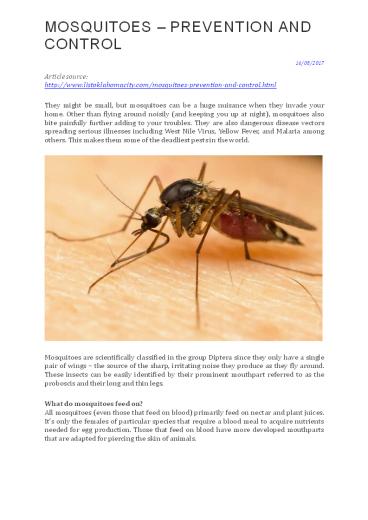MOSQUITOES – PREVENTION AND CONTROL - PowerPoint PPT Presentation
Title:
MOSQUITOES – PREVENTION AND CONTROL
Description:
Visit at They might be small, but mosquitoes can be a huge nuisance when they invade your home. Other than flying around noisily (and keeping you up at night), mosquitoes also bite painfully further adding to your troubles. They are also dangerous disease vectors spreading serious illnesses including West Nile Virus, Yellow Fever, and Malaria among others. This makes them some of the deadliest pests in the world. – PowerPoint PPT presentation
Number of Views:226
Title: MOSQUITOES – PREVENTION AND CONTROL
1
MOSQUITOES PREVENTION AND CONTROL 16/08/2017
Article source http//www.listoklahomacity.com/mo
squitoes-prevention-and-control.html They might
be small, but mosquitoes can be a huge nuisance
when they invade your home. Other than flying
around noisily (and keeping you up at night),
mosquitoes also bite painfully further adding to
your troubles. They are also dangerous disease
vectors spreading serious illnesses including
West Nile Virus, Yellow Fever, and Malaria among
others. This makes them some of the deadliest
pests in the world.
Mosquitoes are scientifically classified in the
group Diptera since they only have a single pair
of wings the source of the sharp, irritating
noise they produce as they fly around. These
insects can be easily identified by their
prominent mouthpart referred to as the proboscis
and their long and thin legs. What do mosquitoes
feed on? All mosquitoes (even those that feed on
blood) primarily feed on nectar and plant juices.
Its only the females of particular species that
require a blood meal to acquire nutrients needed
for egg production. Those that feed on blood have
more developed mouthparts that are adapted for
piercing the skin of animals.
2
Several groups of people are more prone to
mosquito bites. They include pregnant women,
heavy breathers, people that produce more body
heat, those with O blood type and people that
have a lot of bacteria on their skin.
3
- The lifecycle of the mosquito
- Mosquitoesgo through four phases of development
Egg, Larva, Pupa, and Adult. Once the female has
mated, it will search for animal blood to acquire
the nutrients it needs to produce eggs. When it
gets the blood meal, the mosquito will then look
for standing water where it will lay its eggs.
One female mosquito can lay as many as 100 eggs.
These will hatch into larvae in as little as 48
hours depending on the conditions. - The larvae will then continue living in water and
feed on micro-organisms and other organic
matter. Theyll moult several times as they grow
and develop and finally turn into pupa. - The pupa stage (also referred to as the resting
stage) is where the immature mosquito develops
all its distinguishing features. Although at
rest, the pupa will occasionally tumble in
response to light changes. The pupa will
eventually split to release a fully developed
mosquito after about 14 days marking the end of
the development cycle. - How do I prevent a mosquito infestation?
- Therere several preventive measures you can take
to keep these potentially dangerous - pests out of your home. These include
- Clearing overgrown vegetation in and around your
property and keeping your lawn mowed. These
would otherwise provide shelter and food for
mosquitoes that will most probably end up inside
your home. - Draining any standing water near your house as
this provides good breeding spots for
mosquitoes. - Keeping you doors and windows shut (especially
during the night when mosquitoes are most
active) if they are not screened. - Controlling mosquitoes
- If mosquitoes are still a problem even after
taking these measures, you can get rid of them
by - Using mosquito traps.Mosquito traps use heat and
carbon dioxide as bait for attracting mosquitoes
before sucking them into a secure chamber using a
powerful fan. They are discreet, effective and
ideal for outdoor use. - Bug zappers. These work by electrocuting the
mosquitoes and other undesired bugs to death
effectively keeping them out of your hair.































